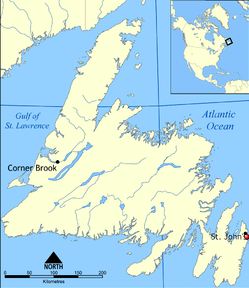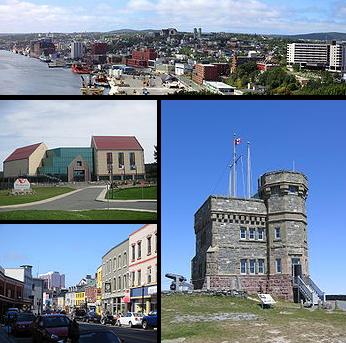- Study in AustraliaAustralian Universities/CollegesPrograms by faculty AusAustralian VisasLife in Australia
- Study In New ZealandNew Zealand UniversitiesPrograms by Faculty NZNew Zealand VisasLife in New Zealand
- Study in CanadaUniversities/Colleges in CANADAPrograms by faculty CanadaCanadian VisasLife in Canada
St. John's
| St. John's | |||
| St. John's is the capital and largest city in Newfoundland and Labrador, and is the oldest English-founded city in North America. It is located on the eastern tip of the Avalon Peninsula on the island of Newfoundland. With a population of 196,966 as of 2011, the St. John's Metropolitan Area is the second largest Census Metropolitan Area (CMA) in Atlantic Canada after Halifax and the 20th largest metropolitan area in Canada. Its name has been attributed to the feast day of John the Baptist, when John Cabot was believed to have sailed into the harbour in 1497, and also to a Basque fishing town with the same name. | | ||
 | |||
| Newfoundland was claimed as an English colony in the name of Elizabeth I in 1583, temporarily captured by the Dutch in 1665, and attacked three times by the French who captured and destroyed its settlements in 1689 and 1707. St John's was retaken each time and re-fortified. British forces used St. John's fortifications during the Seven Years' War in North America, the American Revolutionary War and the War of 1812. St. John's served Allied needs in World War ll by providing an air base for the US Army Air Corps and a harbour for antisubmarine warfare ships. St. John's, and the province as a whole, was gravely affected in the 1990s by the collapse of the Northern cod fishery, which had been the driving force of the provincial economy for hundreds of years. After a decade of high unemployment rates and depopulation, the city's proximity to the Hibernia, Terra Nova and White Rose oil fields has led to an economic boom that has spurred population growth and commercial development. As a result, the St. John's area now accounts for about half of the province's economic output. The architecture of St. John's has a distinct style from that of the rest of Canada, and its major buildings are remnants of its history as one of the first British colonial capitals. Buildings took a variety of styles according to the means available to build the structures. Starting as a fishing outpost for European fishermen, St. John's consisted mostly of the homes of fishermen, sheds, storage shacks, and wharves constructed out of wood. Like many other cities of the time, as the Industrial Revolution took hold and new methods and materials for construction were introduced, the landscape changed as the city grew in width and height. The Great Fire of 1892 destroyed most of the downtown core, and most residential and other wood-frame buildings date from this period. Often compared to San Francisco due to the hilly terrain and steep maze of residential streets, housing in St. John's is typically painted in bright colours. The city council has implemented strict heritage regulations in the downtown area, including restrictions on the height of buildings. These regulations have caused much controversy over the years. With the city experiencing an economic boom a lack of hotel rooms and office space has seen proposals put forward that do not meet the current height regulations. Heritage advocates argue that the current regulations should be enforced while others believe the regulations should be relaxed to encourage economic development. John's economy is connected to both its role as the provincial capital of Newfoundland and Labrador and to the ocean. The civil service which is supported by the federal, provincial and municipal governments has been the key to the expansion of the city's labour force and to the stability of its economy, which supports a sizable retail, service and business sector. The provincial government is the largest employer in the city, followed by Memorial University. With the collapse of the fishing industry in Newfoundland and Labrador in the 1990s the role of the ocean is now tied to what lies beneath it – oil and gas – as opposed to what swims in or travels across it. The city is the centre of the oil and gas industry in Eastern Canada and is one of 19 World Energy Cities. ExxonMobil Canada is headquartered in St. John's and companies such as Chevron, Husky Energy, Suncor Energy and Statoil have major regional operations in the city.[48][49] Three major offshore oil developments, Hibernia, Terra Nova and White Rose, are in production off the coast of the city and a fourth development, Hebron, is expected to be producing oil by 2017. The economy has been growing quickly in recent years. In both 2010 and 2011, the metro area's gross domestic product (GDP) led 27 other metropolitan areas in the country, according to the Conference Board of Canada, recording growth of 6.6 per cent and 5.8 per cent respectively. At $52,000 the city's per capita GDP is the second highest out of all major Canadian cities. Economic forecasts suggest that the city will continue its strong economic growth in the coming years not only in the "oceanic" industries mentioned above, but also in tourism and new home construction as the population continues to grow. In May 2011, the city's unemployment rate fell to 5.6 per cent, the second lowest unemployment rate for a major city in Canada. St. John's is also becoming known as an entrepreneurial city. In a 2009 report by the Canadian Federation of Independent Business; Communities in Boom: Canada’s Top Entrepreneurial Cities, St. John's was ranked the best major city in Atlantic Canada, and 19th overall in Canada for providing a good environment for small business development.[ The downtown area is the cultural hub of St. John's and is a major tourist destination in Newfoundland and Labrador and Atlantic Canada. Both Water Street and Duckworth Street are known for their brightly coloured low rise heritage buildings which house numerous tourist shops, clothing boutiques, and restaurants. George Street, a downtown side-street above the western end of Water Street, is the predominant home of the city's nightlife. The street holds numerous annual festivals including the George Street Festival in August and the Mardi Gras Festival held in October. The street can be credited with kick starting the careers of many musical acts and is busy nearly every night of the week. The LSPU Hall is home to the Resource Centre for the Arts. The "Hall" hosts a vibrant and diverse arts community and is regarded as the backbone of artistic infrastructure and development in the downtown. The careers of many well-known Newfoundland artists were launched there including Rick Mercer, Mary Walsh, Cathy Jones, Andy Jones and Greg Thomey. The St. John's Arts and Culture Centre houses an art gallery, libraries and a 1000 seat theater, which is the city's major venue for entertainment productions. | |||
For more information, please contact one of our offices
Study in Australia | Study in the UK | Study in Malaysia | Study in Canada | Study in the USA | Study in New Zealand















